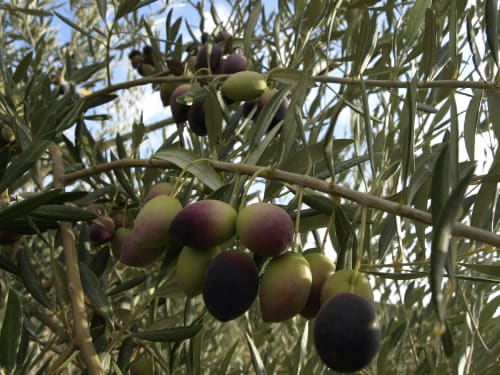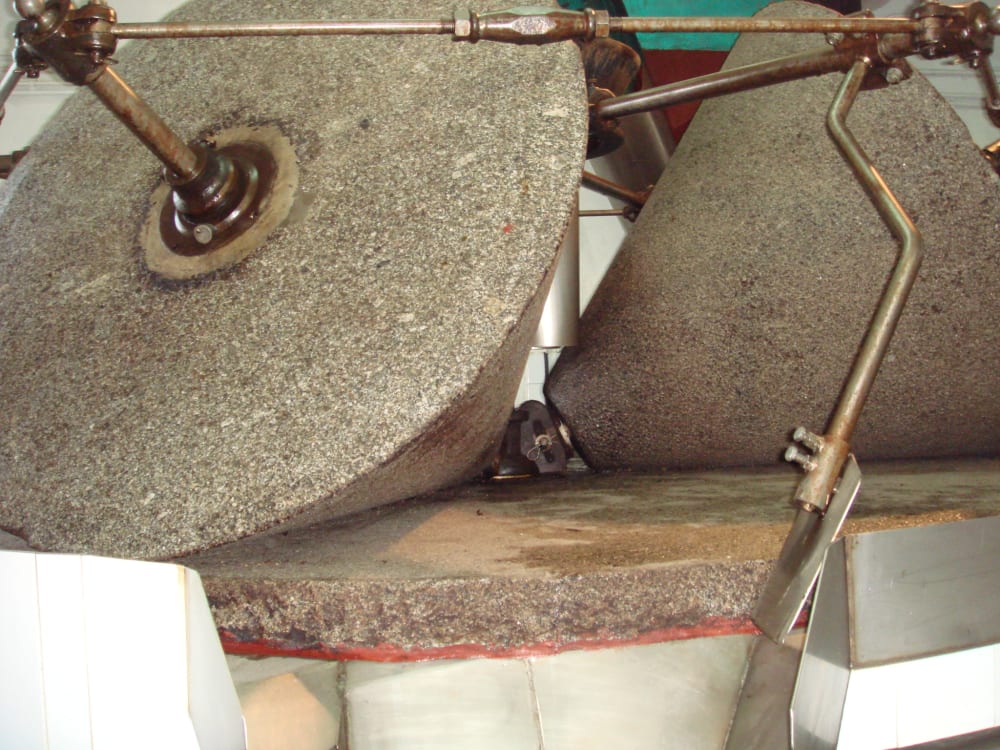One of the Last Old-Style Olive Oil Mills
October 2008




Once upon a time, a man named Antonio Rey was born in a hamlet located along the Ebro River in Cataluña. I suppose it was not a particularly noteworthy event, yet there are people whose lives are quietly remarkable - even though the self-important world may not take much notice.
Antonio had an engineer's heart. From the time he was a boy he enjoyed taking things apart and putting them together. If he had access to even rudimentary tools, he was happy employing his innate gift to repair whatever needed attention.
When Antonio grew to be a young man, his family helped him to purchase a gasoline station, where in addition to filling people's gas tanks, he could help making minor auto repairs. He married and bought an older home in the town, which he looked forward to renovating as he could find time. Together he and his wife, Maria Cinta, began settling down to what they anticipated would be an uneventful life, but one which might be fulfilling as they raised two children, two boys named Pau (now 18) and Joseph (now 8).
However, Antonio's life would forever change the day he was rummaging around in the basement of his new home and found parts of an antique olive mill – of the kind used for centuries before the advent of electricity. He became completely enthralled by this relic of another era and spent hours and days tinkering with the inner workings of the machine - studying its construction and tracing back its history. Pumping gas and making auto repairs was one thing, but his heart was with the olive mill.
It was not long before he desired to spend his life replicating the antique tradition of olive pressing, by using essentially the same processes that his ancestors had employed hundreds of years before. Olive oil production has always been central to the life of the people of Tarragona, but nowadays the noise of the whirring blades and spinning centrifuges of modern production have replaced the simplicity of an earlier time.
However, to follow this quest he needed to find an olive mill in working order, as well as the accompanying press. He searched all over Spain, and finally, in far away Córdoba, Antonio located a classic olive mill – purported to be one of the oldest ones operating in Spain before it had been "put out to pasture," so to speak.
Now the question was where to locate. It should be somewhat near his home so that he could still support his family. Yet it should be near the olive trees where he could feed his soul.
An impressive hydroelectric project was underway not too far from his town, which involved building a dam at the confluence of the Cinca and Ebro rivers. The project entailed flooding a valley and relocating the village called Mequinenza high above the waters of the new dam.
Above the mountainside village were hundreds of wild olive trees, which had not been tended for years. Just the perfect spot, Antonio thought, to realize my dream. I will build an authentic medieval olive mill. The olive trees that surrounded the site were the epitome of organic farming since they had grown naturally for centuries.
The reason these trees grow naturally is that olive groves grown in lower altitudes are devastated by a white fruit fly, which can only be combated by the grower spraying the branches with insecticide. The wild trees, on the other hand are growing at a higher altitude where prevalent winds keep away the pest. There is no need to disturb the ecological balance.
It was here where my son Jonathan and I caught up with Antonio. Our dear friends, Hans and Daida who are deeply involved in the culture of olive oil, introduced him to us. One sunny April afternoon Antonio ushered us inside his unassuming building to see his pride and joy: a fabulous antique olive mill composed of three massive conical granite grinding stones, weighing more than two tons each, rotating on a horizontal millstone, which weighed another 5,000 pounds.
Local farmers provide Antonio's mill with their olives, gathered by hand from neglected groves – some with 200 to 300 year old trees. Some are only recently accessible due to the location of the new dam. Because the trees are not cultivated, but growing in the wild, the blend of olives varies each harvest.
The farmers bring in small tractor loads of olives, which are blown with a fan to be rid of twigs and leaves, then washed, and fed into the area of the mill where the massive granite cones converge. Here they are crushed into a mulch/paste composed of up to 60% water derived from the olives, 25% olive oil and the rest fiber and pulp from the stones, (called huesos or bones in Spanish). In modern mills, stainless steel blades whirring at over 1,000 revolutions a minute produce this mulch.
The proud man then escorted us over to the press itself, where he showed us what a labor-intensive job is ahead of him once the paste is produced. He has an upright steel spindle upon which he mounts filtering discs — about 3 feet in diameter, with a central hole.
For centuries, these discs were made of esparto grass as tough as palm fronds. (You can see the same material woven into a paella tray we have at La Tienda.) Today, in one of his few concessions to modernity, he uses polypropylene discs which are easy to clean and do not become rancid with oil. In addition, they impart no flavor, as esparto grass does, affecting the purity of the oil.
Patiently he stacks the discs one by one, manually spreading about two fingers depth of crushed olives between them until he has created a 70 or 80-layer sandwich. Then he presses out the oil with a hydraulic press driven by water (hence the name), not by the 19th Century innovation of oil.
This is what "first cold press" originally meant: olives mashed and then pressed. Today the phrase is an anachronism. A centrifuge accomplishes Antonio's laborious process in the twinkling of an eye. "Pressing" is a thing of the past.
To Jonathan and me, the next stage was the most fascinating. Rather than purifying the fresh oil through a second centrifuge followed by commercial sand and filters, Antonio follows a tradition that stretches back to Roman times. He decants the oil employing nothing but gravity.
The fluid streams into a series of masonry cisterns which have three levels of steps. In the first cistern is perhaps 8 inches of oil floating over 20 inches of water and impurities. The heavier water drains away – and the purer oil flows to the next cistern where the process is repeated, and then again to a third cistern. By now, all the water and impurities have been left behind and the pure golden oil is deposited in large underground masonry cisterns that keep it at a constant cool temperature, protected from the light. It takes a man of dedication and conviction to preserve the traditional way. Antonio's is a life of hard work and sacrifice to achieve his dream.
What is the difference between wild olive oil pressed the medieval way and one extracted with modern technology? Antonio would point out that there are some olive flavors retained only in his oil, since the traditional method of oil extraction is not as efficient as the centrifuge. Also his oil has more texture (syrupy) and still tastes great long after centrifuge oil has gone stale.
Most of all, the difference is intangible. With a great deal of inner satisfaction Antonio knows that that the fruit of his labor is close to the earth – no filters, no machinery - just pure olive juice from wild trees derived the way it has been for thousands of years.
Antonio's mill is one of less than a half dozen olive mills in Spain that preserve the medieval way. What does the future hold? His son Pau, age 18, works at his father's side when he is not at school. He shares his father's pride in this remarkable labor. On the other hand, Pau told Hans the other day that he also is intrigued by IT – information technology!
My best to you and those whom you love,
Don

